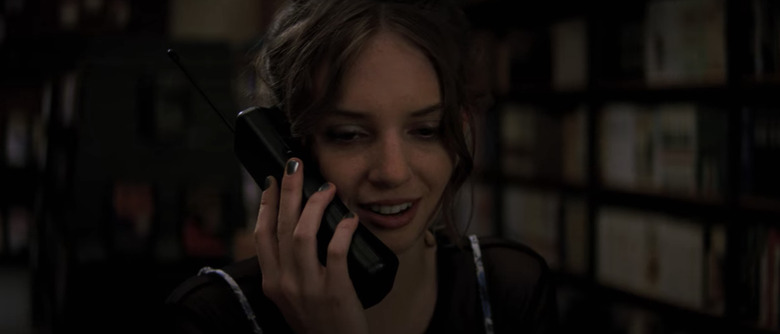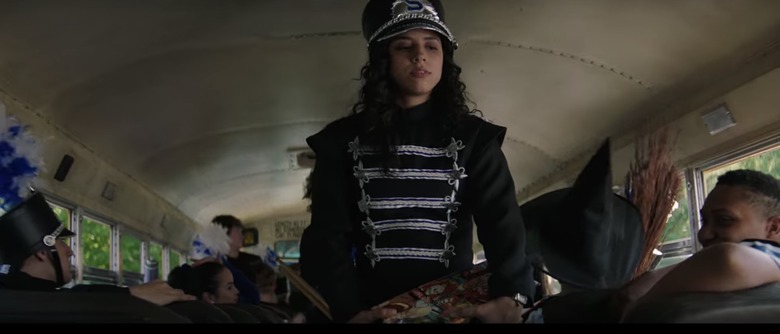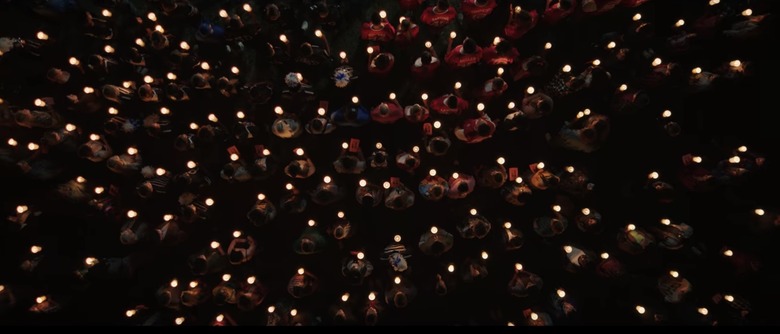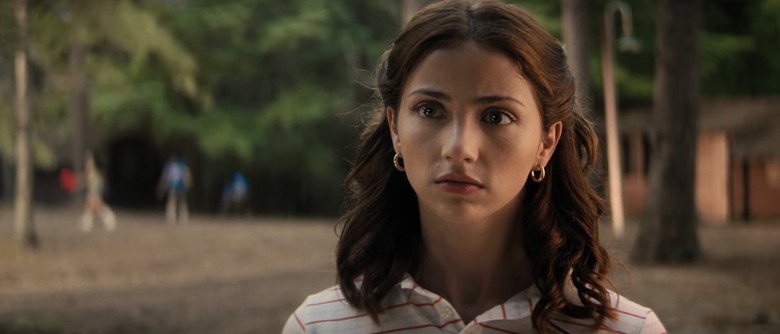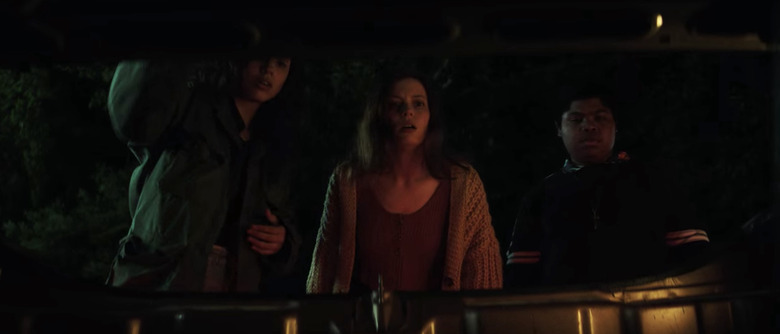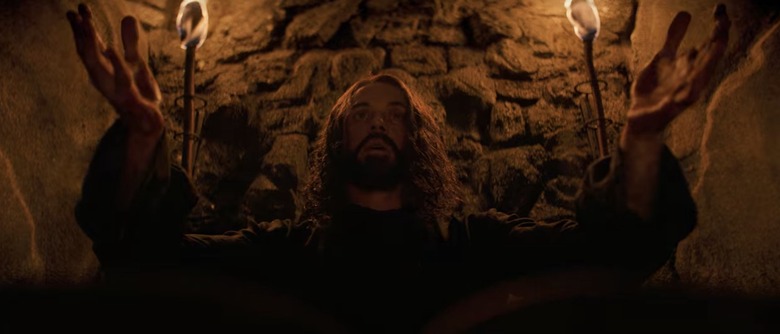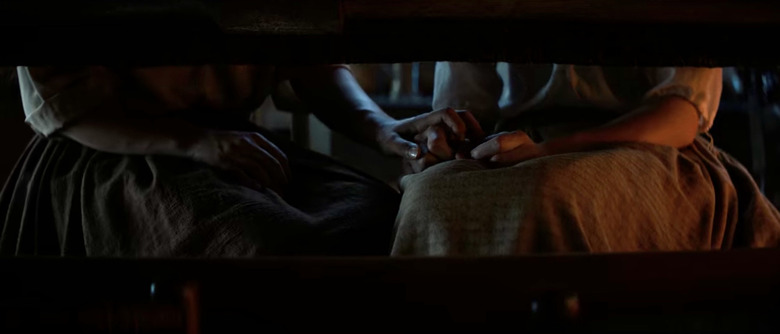'Fear Street' Spoiler Review: Netflix's Horror Trilogy Mines Nostalgia While Looking To The Future
Netflix's Fear Street trilogy, a three-week spree of crimes against innocent Shadysiders, ended on Friday. It's possibly the biggest slasher-movie event since the 2018 Halloween broke box-office records for its franchise and production company. There have been other slasher flicks since then; the bloody body-swap Freaky comes to mind as one genre torch-bearer, seen mostly on VOD late last year. However, with its staggered release pattern — instant summer sequels, now available to stream! — Fear Street has built up a sustained momentum this month that goes unmatched by other recent entries in the genre.
We took a non-spoiler look at all three Fear Street films as they launched: Part One: 1994 on July 2, Part Two: 1978 on July 9, and Part Three: 1666 on July 16. Now, as the dust settles in the town of Shadyside, we're ready to dive into the deep end with a spoiler-filled look at the plot twists, character deaths, and buried themes of the whole decade-hopping trilogy.
These Are Literate (and Cineliterate) Horror Films
Fear Street Part One: 1994 opens with an homage to Scream, Wes Craven's meta 1996 slasher. Because of her work on Stranger Things, Maya Hawke is probably more well-known than the other young actresses in Fear Street, which means that as soon as she shows up onscreen, you know they're going to go the Drew Barrymore route with her. In a bookstore at the mall, we meet her character, Heather, who compliments a customer on her choice of reading material.
Though Heather holds the author's name out of frame, we can still see the title and cover art and, fittingly, it's an R.L. Stine novel, The Wrong Number. Fear Street is, of course, loosely adapted from Stine's book series, which made its initial run from 1989 to 1999. That puts Part One: 1994 squarely in the middle of what a nostalgic '90s teen might call the "Fear Street Decade."
Later, as Heather locks up and the camera pans across the bookshelves, we'll see more of those old novels, with the pseudonym, "Robert Lawrence," on the cover. The "R.L." in Stine's name is, in fact, short for Robert Lawrence. However, the customer regards The Wrong Number as trashy, low-brow horror. She's only buying it as a gift for her stepdaughter. Heather flicks her off as she walks out the door, and soon, we're off to the races.
The first of many needle drops is "Closer" by Nine Inch Nails. 1994 was the year of the band's quadruple-platinum album, The Downward Spiral. Tangentially, Trent Reznor, who has since gone on to become an Oscar-winning film composer, recorded most of that album at the same Hollywood Hills address where the real-life Manson Family committed the Tate murders in 1969. Reznor was the last resident of the original house before it was demolished in 1994.
Hawke played one of the Manson girls in Quentin Tarantino's Once Upon a Time in Hollywood. This is just one example of how layered Fear Street Part One: 1994 is regarding its pop culture references. Nine Inch Nails equals Tarantino equals Fear Street. There's even the standard trunk shot. We'd need a Shadysider herself to explain all the Easter eggs.
Suffice it to say, a phone ring cuts through the silence and Heather soon finds herself being stalked by a knife-wielding killer in a white mask and black hood. Instead of Scream's Ghostface killer, it's Skull Mask, a seemingly witch-possessed version of her fellow mall worker, Ryan (David W. Thompson). He creeps up on her from behind and tries to stab her in the gut but she's holding a book and it stops the knife from going in. See, kids: if you read a book, it could save your life.
Fear Street Part One: 1994 Layers On the Music Thick
So, with all the Scream homages, why isn't Fear Street Part One set in 1996, the year the Ghostface killer started terrorizing teens on celluloid? Well, aside from our "Fear Street Decade" hypothesis, one reason might be because '94 was the year that Craven returned to another seminal slasher franchise on a place called Elm Street.
Wes Craven's New Nightmare was the maestro's first foray into meta-horror and it remains one of his best films, not to mention the second-best Freddy Krueger flick. The movie hit theaters in October '94 and that's the month we see listed in newspaper clippings about the Shadyside Mall massacre.
Skull Mask finally catches up with Heather and plunges the blade deep into her chest. The entirely well-meaning (or so we're led to believe) Sheriff Nick Goode, played by Ashley Zukerman, arrives on the scene and shoots him in the head. Yet the killer will turn up again later at the police station, magically reanimated despite being dead.
In Fear Street Part Two: 1978, we'll also learn that this mall is built on top of the camp where the supposed "witch" Sarah Fier's skeletal hand is buried. The same tree is still there, growing up out of the ground in the center of the mall.
When we meet the real heroine of Fear Street, Deena (Kiana Madeira), she's writing an angry note to her ex, Sam, while "Only Happy When It Rains" by Garbage plays in the background. Similar to most of us (as teenagers), Deena inhabits a world of absentee adults like a regular Peanuts character. Her dad is MIA but she lives with her brother, Josh (Benjamin H. Flores).
Josh spends his time in AOL chat rooms, discussing Shadyside's long history of murderous rampages with an eldritch buddy named @queenofairanddarkness. Said history predates the mall massacre and it includes some killers/decades that didn't receive their own dedicated Fear Street film, like the Milkman in '53 or Ruby Lane in '65.
It's when Deena and Josh are in the halls at school that the soundtrack starts to feel a little trigger-happy and ostentatious in terms of pumping out the '90s jams. "Machinehead" by Bush segues into "Damn I Wish I Was Your Lover" by Sophie B. Hawkins, which, in turn, segues into "Sour Times" by Portishead.
This three-song medley all happens in less than a minute, and the Bush track notably comes from an album that wasn't released until December 1994. ("Everything Zen" was the pre-release single, not "Machinehead.") So the filmmakers are playing fast and loose with alt-rock history, and here and elsewhere, they could have probably withstood a brief moratorium on needle drops.
When Deena boards the bus in her embarrassing band uniform, Cypress Hill's "Insane in the Brain" accompanies her. When she sits down in her seat, she puts on her Walkman headphones...and now we're in the middle of Radiohead's "Creep." A moment like this might have worked better if the movie had filled our ears, first, with just the noise of Deena's fellow high schoolers aboard the bus, before letting us retreat with her into the lush sounds of her private Radiohead world.
Deena’s Sexual Identity Plays on Preconceived Notions
It's while Deena is at a candlelight vigil for her hall-locker neighbor, Heather, and the other mall massacre victims, that Fear Street Part One delivers its next subtle twist. Deena scans the crowd and lands on a football player and cheerleader in Sunnyvale uniforms. Director Leigh Janiak, who helmed the nightmare Honeymoon, shows the football player's face full-on while relegating the cheerleader to a shadowy sidelong profile.
That shot, and the gender-neutral name, "Sam," set us up for the bait-and-switch, where it turns out to be the cheerleader, not the football player, who is Deena's ex. As Deena sits with a box of her old flame's belongings, flashes of memory prep us for this by showing the same scene with the cheerleader's face (and groped skirt) in focus.
If you're a member of the LGBTQ community, you might latch onto her as queer, which is what her character happens to be. Janiak's co-writer, Phil Graziadei, is openly gay. The director spoke to The Wrap about how they and their writers' room were "acutely aware of the history of how queer characters are generally portrayed in horror films." They handle the reveal here matter-of-factly, but for a split second, Deena's un-closeting comes across as one of those guess-who's-gay moments that the entertainment industry likes to trot out as proof that it's progressive (in spite of its questionable history).
It seems designed to subvert expectations — the Bury Your Gays trope, sometimes seen in horror — and tip the balance from queerbaiting into meaningful representation. To their credit, Madeira and Olivia Scott Welch, who portrays Sam, are good enough actors that they are able to sell their characters' relationship as real. There are genuine tears in Deena's eyes as she rages:
"There's not much of a future in Shadyside with a lesbo. Best case is, what? Dead on the mall floor after a double shift? Or maybe, maybe if you're really lucky, you're the one carrying the knife."
Sam does become a prime target for the pseudo-witch's resurrected avatars, but as CBR notes, the moral predicament of sacrificing or saving her leads the other characters to try purposely killing her but then bringing her back to life. It's as if her lobster tank drowning is meant to revive her and other marginalized people as something more than slasher cannon fodder. Not only does Sam come back to life; the witch appears to take possession of her. She and her girlfriend have gone from being the would-be victims to the stars of the movie.
Instead, it's Deena's friends, Kate and Simon (Julia Rehwald and Fred Hechinger) who get fed through the meat grinder. One of them, almost literally.
The Kills Are Gruesome and Personal and Stay That Way in 1978
On its way to the candlelight vigil, we see Deena's school bus pass through the run-down town of "Sh***yside," as one graffitied sign proclaims it. Soon, it passes the stately homes of Sunnyvale's residents. The town's name recalls Sunnydale in Buffy the Vampire Slayer, so much so that viewers might easily confuse the two names. The mid-'90s were also the creative peak of a little show called The Simpsons, and Shadyside and Sunnyvale have a real Springfield vs. Shelbyville thing going on.
In the opening credits, we see that Sunnyvale has been voted "Most Beautiful Place to Live" while Shadyside is known as the "Killer Capital USA." True to form, there are many gut-wrenching deaths in Shadyside history and that is another way Fear Street subverts slasher tropes. It makes us care about the characters before killing them. It's one thing when Skull Mask eviscerates Sam's jerky jock boyfriend, Peter (Jeremy Ford) in the hospital. Peter's a character written to be as unlikable as possible.
On the other hand, hanging out with Deena and her friends for so long makes them start to feel like our friends. They're not just expendable human props, kids bussed in from the modeling agency to hit their marks and promptly die.
Casting director Carmen Cuba did an altogether great job scouting new faces. Most of the young actors in the Fear Street trilogy have the right magnetic quality to hold the screen and make their characters resonate as true teens with insecurities and angst and inner lives of their own. Rehwald makes an impression as the drug-peddling valedictorian, Kate, who is Josh's dream girl and who finally goes "barely first base" with him in a bathroom stall before her gruesome demise.
It's a Kmart-inspired bread slicer, not some figurative meat grinder, that kills Kate, mistaking her brains for bread and slicing them just the same. Not long after, an axe to the head does in Simon, and the trilogy is just getting warmed up.
With its time and setting (a summer camp, counselors in striped tube socks), Fear Street Part Two: 1978 evokes both John Carpenter's Halloween and its Golden-Age slasher contemporary, the original Friday the 13th. At the candlelight vigil, the adult Nick Goode has already told us, "There's no peace found in the past." Sure enough, Camp Nightwing is a place where more teens lose their lives.
We meet the young version of Nick (Ted Sutherland) and witness him rescue Ziggy Berman (Sadie Sink, another Stranger Things alumna) from camp bullies. By the end, Ziggy will be left bleeding out on the ground next to her sister, Cindy (Emily Rudd), who has a thing about not cussing. F-bombs seem trivial when you're fighting for your life — and eventually having your chest caved in by an axe-wielding psycho, the same burlap-sack-wearing automaton who will butcher Simon later in the Fear Street trilogy's timeline.
Cindy's death, the repeated bludgeoning of her body with a sharp object, verges on wildly gratuitous. Yet this is another case where the trilogy twists the knife in ways that other slasher film series can't, simply because they tend to foreground their killers as icons. Jason and Michael Myers dispatch disposable teens and live to slay again in another sequel, with fans rooting for them and their "kills" because, after all, they're the real stars. Forget Laurie Strode. (You shouldn't, though, she's awesome.) But here, we feel every blow. And it hurts.
Part Two Looks Backward But Keeps the Trilogy Moving Forward
Like Laurie, Ziggy winds up being the Final Girl, '78 edition. She's the survivor who grows up to tell Deena her harrowing tale via flashback. Adult Nick slips the note through her mail slot that it's "happening again" in '94.
Surprise, surprise: Ziggy took her deceased sister's name. This is played like a twist, but it lands softer than others we've already discussed. The average viewer probably isn't going to be paying enough attention to character names that it will hit them like a bombshell revelation when they realize that "C. Berman" is, in reality, her sister, Ziggy.
Thanks to Rudd's performance, the true Cindy never feels like some goody-two-shoes caricature. She just seems like an older sister who's trying to be responsible. It's her fellow camp counselor and estranged friend, Alice (Ryan Simpkins), who initially proves more annoying, with her performative rebellious shtick.
They wind up underground together, in a tunnel system shaped like the Witch's Mark, where they stumble across the devil's beating heart (or pulsing organs, or something). His spirit enters Cindy's boyfriend, Tommy (McCabe Slye). When, at last, Tommy catches up with poor Alice, she's been through enough and redeemed herself enough that we're now sad — if unsurprised — to see her gutted in an untimely fashion.
Fear Street Part Two continues the music blitz, blasting '70s songs like "Cherry Bomb" by The Runaways and "Carry On My Wayward Son" by Kansas over the cassette deck and intercom at Camp Nightwing. It also provides a bit of linkage between the two eras in the form of "The Man Who Sold the World," both the original David Bowie version and the live acoustic cover recorded by Nirvana for its 1994 album, MTV Unplugged in New York.
Speaking of pop-culture events in '94, it's worth noting that Fear Street aspires to a Forrest Gump level of period-appropriate jukebox hits. Though the music obeys a diegetic conceit in places, the filmmakers aren't always successful in integrating it into the narrative in a way that feels organic. Watching the first two-thirds of the trilogy does occasionally feel like playing a game of Now That's What I Call Music: Teen Horror Edition!
Due to its period setting in Colonial America, this is less of a problem with Fear Street Part Three: 1666. And even in the '90s, it's arguably still true to the tradition of teen slashers if you think, for instance, about how I Know What You Did Last Summer prominently featured a cover of Deep Purple's "Hush."
Big picture: after watching Fear Street Part One, early millennials might feel as old as they did during Captain Marvel, which infused its soundtrack with a similar retro collection of '90s songs. After watching Part Two, folks in the audience might have Bowie's cross-generational B-side or other classic rock songs stuck in their head. That's not necessarily a bad thing, and it's a testament to the trilogy's ingenuity that the element worthy of the most criticism here, so far, is its occasionally overeager soundtrack.
Part Three: 1666 Wants a Sip of Applejack From the Patriarchy
As the Weinstein effect rippled through Hollywood, the words "witch hunt" were often casually wielded against the #MeToo movement, turning a term that originated from the false accusation of women into a weapon against women who were accusing powerful men. In the end, Fear Street lands firmly on the side of a woman who's been demonized as a witch and oppressed by a powerful man. Sarah Fiers, the ostensible movie monster, turns out to be the unsung hero of Union, the 1666 colony with a greatest-hits mix of 1994 and 1978 faces.
The buried secret in Shadyside is that Sarah sacrificed herself and falsely confessed witchery to save her lover. Up is down, left is right, and "Goode is evil." Making the Goodes into the bads and the witch possessions into devil possessions is a neat twist that goes a long way toward redeeming the trilogy's slightly uneven third act/movie.
Fear Street Part Three: 1666 is really two TV episodes packaged as one film. The 1666 half is less successful because it never quite advances beyond the feel of an anachronistic assembly of teenagers playing costume dress-up with Irish accents.
The decision to have Deena see things through the eyes of Sarah Fiers is understandable, as is the decision to have the same actor play Adult Nick Goode and his devil-worshipping pilgrim forebear, Solomon Goode. But whereas Part One and Part Two each introduced a new cast of characters and made us feel for them, Part Three can only rely on our existing attachment to Deena and Sam.
The teens of Union just want to pop mind-altering berries at campfire parties, but the repressive religious crazies in their colony won't let them. Their food is poisoned, they're cursed by Satan and a litany of other demons (Azazel, Abaddon, Beelzebub, Moloch, the usual suspects), and the local rev's gone cuckoo. He cuts his own eyes out in church and murders the colony's younglings.
It's all very familiar, but maybe I'm just desensitized. At one point, 1666 Simon (or his ancestor, whoever he's supposed to be) gets up in the pulpit and cries, "We drank applejack! We danced! We are young! That is not a crime!" Angry, bearded Puritans shout back, "Heathens!" and, "You have sinned!"
Scenes like this border on risible, like a high-school parody of The Crucible or The New World, both of which Janiak has cited as influences. Thankfully, the last part of the movie makes a return to the present, as a second title card drops, informing us that this is now Fear Street 1994: Part 2 (so, really, Part One: 1994: Part 2.)
1994: Part 2 Brings the Trilogy’s Themes Into Full Focus
In '94, Deena, Josh, the adult Ziggy, and the janitor, Martin (Darrell Britt-Gibson, suddenly playing a much more prominent part) booby-trap the mall and lure the supernatural killers in. They Super-Soaker them with blood, as bait, and we get a big melee where all the killers try to kill each other and succeed, before reanimating. Deena is stabbed, but she survives because, underneath her shirt, she's fashioned a knife-proof vest of R.L. Stine books.
Is it plot armor? Maybe. But remember, this is a callback: if you read (or wear) a book, it could save your life.
Deena stabs Sheriff Goode in the eye — no, really, damn his eyes — and she and Sam are reunited as a couple. It wasn't "just a dalliance" between these two girls: they're meant for each other, as if all of Shadyside's history has been leading up to their rekindled romance.
They all live happily ever after, though of course, there's the obligatory mid-credits stinger where a hand swipes the book of devil incantations, teasing that the horror isn't over. Before that, Josh, who lost his own love connection to that bread/brain slicer, finally meets his AOL chat buddy in person. Smiling coquettishly, @queenofairanddarkness signs the cast on his broken arm.
Because I happen to share the same name as his character, I always feel like the trilogy is breaking the fourth wall and addressing me personally with expository dialogue like:
"Josh, listen to me. Solomon Goode, Nick Goode's pilgrim ancestor, he made a deal with the devil and then framed Sarah ..."
I hear ya, Fear Street. Loud and clear. The quote above serves as a spoiler-y summation of Netflix's trilogy, which isn't always perfect, but which never fails to entertain. Overall, Fear Street stands as an enjoyable throwback and an impressive artistic achievement. It's a mainstream slasher with subtext, which puts it in fine company with the likes of Carpenter's Halloween, itself a violent coming-of-age movie.
Thematically, Fear Street boils down to a winners-write-the-history-books moral, wrapped up in a tale about outsiders (or "Shadysiders") learning to accept that they are not doomed by nature for being different. Punishment is not a prerequisite unless the real Satanists — those Sunnyvale hypocrites in nice houses with goat heads on the wall — try to make it one. Sarah Fiers tells us she "doesn't fear the devil." She fears "the neighbor that accuses" her. Sometimes, they're one and the same.

